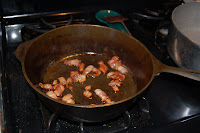 New to my Blogroll is Jonathan Bloom's Wasted Food. Now I try not to waste food, but sometimes I don't try as hard as I should, except when it involves making sure those pralines don't go to waste! But Bloom has made me more aware of the problem, and I'm trying to do better. How can you prevent waste within your own household?
New to my Blogroll is Jonathan Bloom's Wasted Food. Now I try not to waste food, but sometimes I don't try as hard as I should, except when it involves making sure those pralines don't go to waste! But Bloom has made me more aware of the problem, and I'm trying to do better. How can you prevent waste within your own household?First of all, eat the food you buy or prepare. Our downfalls seem to be yogurt and fresh produce. Even if the Ladybirds will eat the out-of-date yogurt and the mushy produce goes into the compost pile, that's not the best use for those foods. Eat what you grow; eat what you buy.
If you can't eat it fresh, freeze it. We have finished maybe a half-dozen entire fresh heads of celery in twenty-five years. But you know what? Celery freezes great. Wash it, throw the leaves and big white ends into your stock vegetables bag in the freezer, and chop the nice green parts and freeze them for red beans and rice or dressing or whatever. Your recipe calls for half an onion -- you know that other half of the onion is going to dry out in your frig. So chop it and freeze it. It's a yellow onion? Be sure to save the skins in your stock vegetables bag. You bought five pounds of hamburger because it was cheaper per pound than one pound? Freeze it THE DAY YOU BUY IT! You made that gumbo three days ago and there's still some left? Freeze it.
Keep your freezer and panty organized so that food doesn't get overlooked. Sort through it periodically to make sure you are using the older stuff.
Are you throwing away free stuff? Do you save your ham bones for bean soup? Your turkey carcass for stock? Your rotissere chicken carcasses for stock? Ham drippings for soups and gravies? Maraschino cherry juice for making pink lemonade? Egg whites for frosting? Egg yolks for dumplings? Broken candy canes for crushing to sprinkle on hot cocoa?
Will your chickens eat it? Bread, rice, popcorn, carrots, apples, tomatoes, noodles, grits, oatmeal, eggshells (toasted so the Ladies don't get any ideas about eating their own). No onions, potatoes, or peppers, please.
Can you compost it? Vegetable and fuit peels (unless they'll do for stock or the chickens), coffee grounds, tea bags, spoiled fruits or vegetables that are too far gone for the chickens, shrimp peels.
And don't overeat. Food that is transformed into heart disease, diabetes, or high blood pressure is a waste of resources, too.
What is it okay to throw alway without feeling guilty? Maybe the bones after you've boiled them for stock. The fat you trimmed off your ribeye, although your chickens would probably actually like that, too.





